Regardless of their tough shells, turtles have several predators that hunt and harm them. All types of chelonians (including freshwater turtles, sea turtles, and land tortoises) have predators.
While turtles have several defenses against predators including tough shells and the ability to withdraw into their shells, they are not one hundred percent safe.
Moreover, not all chelonians can withdraw into their shells. Adult turtles, however, have fewer predators, with juveniles, hatchlings, and eggs having the most predators.
The reason why the turtle population has drastically gone down is because a small fraction of the eggs they lay actually hatch. This is because they’re usually devoured by predators before they have a chance to grow.
In captivity, you must protect your pet turtle from potential predators such as opossums and Raccoons. Even dogs and cats can try to eat your pet chelonian. Adequate protection is paramount.
Even if you have a turtle pond at home, your turtles aren’t completely safe if wild animals can break into your yard. For this reason, this article talks about what eats turtles and how you can keep your turtles safe from predators.
What Eats Freshwater Turtles?
Freshwater turtles unlike their marine counterparts are more likely to be eaten. This is because they are generally not as large as most marine turtles. Since there are many freshwater turtles in existence we will cover only the most popular ones.
Map Turtle (specifically False Map Turtle)
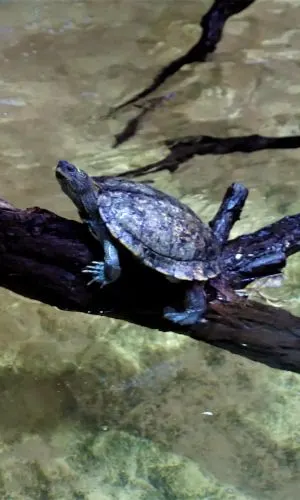
Map turtles (Graptemys) are popular American turtles. These turtles are commonly kept as pets. As pets, they are at risk of being eaten by dogs and even cats.
Some common map turtles species include the northern map (Graptemys geographica), Alabama map (G. pulchra), Ouachita map (G. ouachitensis), False map (G. p. pseudogeographica), Mississippi map (G. p. kohni), Texas map (G. versa), Barbour’s map (G. barbouri), and Black Knobbed map (G. nigrinoda) turtles.
As such protect them from these domestic animals. In the wild, some of their predators include the following.
Predators of the eggs are:
- Maggots (Metoposarcophaga importans)
- Otters (Lontra canadensis)
- Raccoons (Procyon lotor)
- Red foxes (Vulpes vulpes)
Predators of emerging hatchlings are:
- Grackles (Quiscalus quiscula)
- Crows (Corvus brachyrhynchos)
- Great blue herons (Ardea herodias)
- Red-winged blackbirds (Agelaius phoeniceus)
- Ring-billed gulls (Larus delawarensis)
Predators of the hatchlings once they have reached the water are:
- Pike (Esox)
- Catfish (Ictaluridae)
- Bass (Micropterus)
Musk & Mud Turtles (Kinosternidae)

Mud turtles and musk turtles are superb predators themselves. As adults, they have very few predators. When threatened they release a very foul scent that can repel even the fiercest of predators.
Mud turtles belong to the genus Kinsternon. These include over 20 species and many more subspecies. Some mud turtles kept as pets include eastern mud (K. subrubrum), three-striped mud (K. baurii), scorpion mud (K. scorpioides), and Mississippi mud (K. baurii) turtles.
Musk turtles, on the other hand, belong to the genus Sternotherus. Some popular musk turtles include the eastern musk (S. odoratus), flattened musk (S. depressus), and razorback musk (S. carinatus) turtles.
The few known predators eat the eggs and young. These include the following:
- Ray-finned fishes (Actinopterygii)
- Other turtles (Testudines) such as alligator snapping turtle (Macrochelys temminckii)
- Raccoons (Procyon lotor)
- Striped skunks (Mephitis mephitis)
- Water snakes (Nerodia)
- Large-mouth bass (Micropterus salmoides)
- American bullfrog (Lithobates catesbeianus)
- American alligator (Alligator mississippiensis)
Slider Turtles

Slider turtles (Trachemys scripta) are among the most popular turtles kept as pets. These turtles are easy to care for, tough, and resilient. There are three subspecies of sliders and these include red-eared slider (T. s. elegans), yellow-bellied slider (T. s. scripta), and Cumberland slider (T. s. troostii).
In the wild, they have many predators including humans. Even adult sliders have many predators. Some of which include:
- American alligators (Alligator mississippiensis)
- American mink (Neovison vison)
- Armadillos (Dasypus novemcinctus)
- Catfish (Siluriformes)
- Coyotes (Canis latrans)
- Crows (Corvus)
- Gar (Atractosteus)
- Grey foxes (Urocyon cinereoargenteus)
- Humans (Homo sapiens)
- Largemouth bass (Micropterus salmoides)
- Opossums (Didelphis virginiana)
- Otters (Lontra canadensis)
- Raccoons (Procyon lotor)
- Red foxes (Vulpes vulpes)
- Snakes (Serpentes)
- Sriped skunks (Mephitis mephitis)
- White-tailed deer (Odocoileus virginianus)
Cooters (Pseudemys)

The word cooter originates from the word ‘kuta’ which was brought to North America by African slaves. Kuta means turtle in the Malinke and Bambara languages. Cooters make great pets and are relatively successful species. They aren’t threatened nor do they have that many predators.
Species of cooters include the river cooter (P. concinna), Alabama red-bellied cooter (P. alabamensis), Northern red-bellied cooter (P. rubriventris) Florida cooter (P. floridana), Florida red-bellied cooter (P. nelsoni), Rio Grande cooter (P. gorzugi), Texas river cooter (P. texana), and peninsula cooter (P. peninsularis).
So what eats cooters? Well, here are some predators of the river cooter:
- Raccoons (Procyon lotor)
- Virginia opossums (Didelphis virginiana)
- Red foxes (Vulpes vulpes)
- American crows (Corvus brachyrhynchos)
- Otters (Lontra canadensis)
- Fire ants (Solenopsis)
- American alligators (Alligator mississippiensis)
- Dogs (Canis lupus familiaris)
- Black bears (Ursus americanus)
- Hogs (Sus)
- Herons (Ardeidae)
- Turkey vultures (Cathartes arua)
- Humans (Homo sapiens)
- Other turtles
Box turtles (Terrapene)
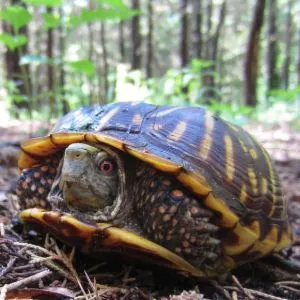
Box turtles are usually confused for tortoises as they have high domes and are usually terrestrial. However, these turtles belong to the family Emydidae (pond turtles). Adults have very few predators as they can retrieve fully into their shells once they are about 5 cm in length. As they grow their shells become thicker and harder. Their hinged shells can close off completely.
Box turtle species include common box (T. carolina), Coahuilan box (T. coahuila), Mexican box (T. mexicana), spotted box (T. nelsoni), ornate box (T. ornata), and Yucatan box (T. yucatana) turtles.
The hatchlings, juveniles, and young however do have predators. These include:
- Raccoons (Procyon lotor)
- Virginia opossums (Didelphis virginiana)
- Striped skunks (Mephitis mephitis)
- Copperheads (Agkistrodon contortrix)
- Coyotes (Canis latrans)
Softshell turtles (Trionychidae)
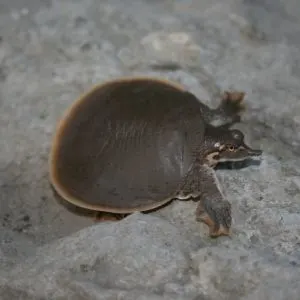
The softshell turtles we will concentrate on are the North American softshells, which is the genus Apalone. These are the more popular softshells. There is very little information on other softshells from around the world especially when it comes to what feeds on them.
For softshells, such as the black softshell turtle, we know humans are the number one predators. American softshell turtles include Florida Softshell (Apalone ferox), Smooth Soft-shelled Turtle (Apalone mutica), and Gulf Coast Spiny Softshell (Apalone spinifera).
Predators of their eggs include:
- American black bears (Ursus americanus)
- Crows (Corvus)
- Raccoons (Procyon lotor)
- Red foxes (Vulpes vulpes)
- Spotted skunks (Spilogale)
- Striped skunks (Mephitis mephitis)
Predators of juveniles include:
- American river Otters (Lontra canadensis)
- Armadillos (Dasypus novemcinctus)
- Cottonmouths (Agkistrodon)
- Eagles (Haliaeetus)
- Everglades kites (Rostrhamus sociabilis)
- Herons and egrets (Ardeidae)
- Red-Bellied turtles (Pseudemys)
- Snapping turtles (Chelydra serpentina)
- Water snakes (Nerodia)
- Alligator snapping turtles (Macrochelys temmincki)
Alligators (Alligator mississippiensis) and humans (Homo sapiens) also prey on adults, juveniles, and subadults.
Painted turtle
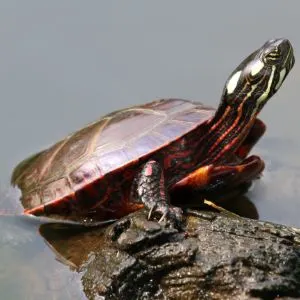
The painted turtle is the commonest turtle in North America. These turtles live in ponds, streams, lakes, and rivers. Since these turtles are widespread, they are commonly bred and sold as pets.
There are four painted turtle subspecies and they include eastern painted (C. p. picta), midland painted (C. p. marginata), western painted (C. p. bellii), and southern painted (C. p. dorsalis) turtles.
Just like other turtles on this list, painted turtles have their fair share of predators. Some of which include:
- American minks (Neovison vison)
- River otters (Lontra canadensis)
- Raccoons (Procyon lotor)
- Red foxes (Vulpes vulpes)
What Eats Sea Turtles?
Sea turtles do not have a lot of predators. This is because they are large and are protected by their shell. However, unlike most freshwater turtles and tortoises, sea turtles cannot withdraw into their shells for protection. This leaves most of their limbs and heads exposed.
However, unlike tortoises, sea turtles are pretty quick and can reach speeds of 22 mph (35 km/hr) when scared. Regardless of this, their exposed flippers and head make them targets for predators such as sharks, and orcas.
According to studies conducted by the Sea Turtle Conservation, as few as 1:10,000 turtle eggs reach adulthood.
Known Predators Of Several Species Of Sea Turtles
Leatherback Sea Turtle

Leatherback sea turtles (Dermochelys coriacea) are huge and as adults have almost no predators occasionally they are attacked by an orca and other large predators. The eggs, hatchlings, and young are most likely to be eaten.
Known predators of Leatherback sea turtle eggs are:
- Coatis (Nasua)
- Dogs (Canis)
- Genets (Genetta)
- Ghost crabs (Ocypode)
- Knots (Calidris)
- Mongooses (Herpestidae)
- Monitor lizards (Varanus)
- Pigs (Suidae)
- Plovers (Pluvialis)
- Raccoons (Procyon lotor)
- Wading birds such as turnstones (Arenaria)
Known predators of the hatchlings include all those mentioned for the eggs in addition to:
- Frigate birds (Fregatidae)
- Gulls (Larus)
- Raptors (Falconiformes)
Known predators of the subadults and adults are:
- Cephalopods
- Requiem sharks (Carcharhinidae)
- Killer whales (Orcinus orca)
Hawksbill Sea Turtle
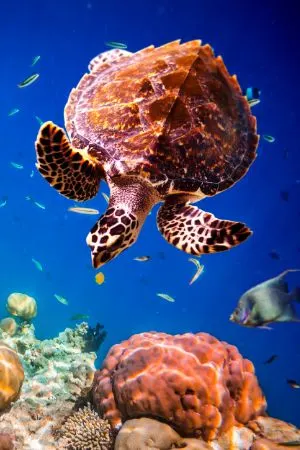
In comparison to other sea turtles, the hawksbill turtle is quite small. As such, even adults have formidable predators.
Known predators of hawksbill eggs are:
- Humans (Homo sapiens)
- Domestic dogs (Canis lupus familiaris)
- Raccoons (Procyon lotor)
- Rats (Rattus)
Known predators of the hatchlings include:
- Common octopus (Octopus vulgaris)
- Domestic dogs (Canis lupus familiaris)
- Estuarine crocodiles (Crocodylus porosus)
- Ghost crabs (Ocypode)
- Groupers (Epinephelus)
- Gulls (Larus)
- Humans (Homo sapiens)
- Raccoons (Procyon lotor)
- Rats (Rattus)
- Requiem sharks (Carcharhinus)
- Tiger sharks (Galeocerdo cuvier)
Known predators of the subadults and adults are:
- Common octopus (Octopus vulgaris)
- Estuarine crocodiles (Crocodylus porosus)
- Humans (Homo sapiens)
- Requiem sharks (Carcharhinus)
- Tiger sharks (Galeocerdo cuvier)
Green Sea Turtle (Chelonia mydas)

Green sea turtles are endemic to the coastal lines of the world’s oceans. They can be found in all the oceans (in tropical and subtropical parts) but are most abundant in the Atlantic and eastern Pacific.
Known predators of green sea turtle eggs are:
- Dogs (Canis lupus familiaris)
- Golden jackals (Canis aureus)
- Humans (Homo sapiens)
- Jaguars (Panthera onca)
- Red foxes (Vulpes vulpes)
Known predators of the hatchlings are:
- crabs (Brachyura)
- Saltwater crocodiles (Crocodylus porous)
- Tiger sharks (Galeocerdo cuvier) and
- Whitetip sharks (Carcharhinus longimanus)
Known predators of the subadults and adults are
- Sharks
- Humans
Loggerhead Sea Turtle

The rough scaly skin and tough shells of adult and subadult loggerheads (Caretta caretta) protect them from predators. However, the younglings and eggs are most vulnerable to predators.
Known predators of loggerhead’s eggs are:
- Red foxes (Vulpes vulpes)
- Dogs (Canis lupus familiaris)
- Hogs (Sus)
- Raccoons (Procyon lotor)
Known predators of the hatchlings include:
- Ants (Formicidae)
- Armadillos (Dasypodidae)
- Bears (Ursus)
- Bobcats and lynxes (Lynx)
- Ray-finned fishes (Actinopterygii)
- Crabs (Decapoda)
- Crows (Corvus)
- Dogs (Canis lupus familiaris)
- Frigatebirds (Fregata magnificens)
- Hogs (Sus)
- Honey badgers (Mellivora capensis)
- Humans (Homo sapiens)
- Opossums (Didelphis)
- Raccoons (Procyon lotor)
- Rats (Rattus)
- Red foxes (Vulpes vulpes)
- Seagulls (Larus)
- Sharks (Chondrichthyes)
- Side-striped jackals (Canis adustus)
- Skunks (Mephitis)
- Small cats (Felis)
Known predators of the subadults and adults are:
- Sharks (Chondrichthyes)
- Humans (Homo sapiens)
Kemp’s Ridley Sea Turtle & Olive Ridley Sea Turtle

The Olive Ridley Sea Turtle (Lepidochelys olivacea) and Kemp’s Ridley Sea Turtle (Lepidochelys kempii) belong to the genus Lepidochelys. Both are threatened species although the Lepidochelys kempii is more threatened with a Critically Endangered conservation status. The Olive Ridley Sea Turtle has a conservation status of vulnerable.
Known predators of ridley sea turtles’ eggs are:
- Humans (Homo sapiens)
- Domestic dogs (Canis lupus familiaris)
- Raccoons (Procyon lotor)
Known predators of the hatchlings include:
- herons
- Humans (Homo sapiens)
- Killer whales (Orcinus orca)
- Raccoons (Procyon lotor)
- seabirds
- Tiger sharks ( Galeocerdo cuvier)
Known predators of the subadults and adults are:
- Humans (Homo sapiens)
- Killer whales (Orcinus orca)
- Tiger sharks (Galeocerdo cuvier)
Flatback Turtle

The Flatback Sea Turtles (Natator depressus) are moderately sized and are strong swimmers. The young are strong swimmers and are not easily caught by predators.
Known predators of Flatback’s eggs are:
- Foxes (Vulpes)
- Dogs (Canis lupus familiaris)
- Pigs & hogs (Sus)
Known predators of the hatchlings when they journey to reach the ocean include:
- Crabs (Decapoda)
- Birds
- Small crocodiles
Known predators of the subadults and adults are:
- Sharks (Chondrichthyes)
- Humans (Homo sapiens)
- Killer whales (Orcinus orca)
What Eats Tortoises?

Tortoises are very tough animals and as such have very few predators. Their large sizes and tough shells mean that few animals mess with them. Tortoises can also fully withdraw into their shells and close their shells off completely.
This offers protection even against the fiercest of predators. However, the eggs and young tortoises aren’t that well protected. Many animals prey on the young and the eggs.
Hatchlings and eggs
Tortoises are most vulnerable when they are young. As hatchlings and eggs, they are defenseless as mother turtles do not take care of their hatchlings nor do they guide the eggs. Animals that eat tortoise eggs include raccoons, boars, crabs, feral cats, feral dogs, humans, birds, and many more.
All these predators have to do is dig up the eggs once they locate the nests. Once a nest is compromised, most of the eggs end up being eaten by scavengers. Even eggs that are buried deep aren’t safe from predators. Once the eggs hatch, the smell of the egg attracts predators.
The acute olfactory sense of predators such as birds, raccoons, and other predators enables them to easily locate the hatchlings. Humans are also responsible for collecting hatchlings for the pet trade, food, traditional medicine, and other consumption.
Adults
Once most tortoises are adults, very few predators bother them.
A list of predators that eat American tortoises such as Desert Tortoise and Gopher tortoise include:
- Humans (Homo sapiens)
- Badgers (Taxidea taxus)
- Bobcats (Lynx rufus)
- Common ravens (Corvus corax)
- Cougars (Puma concolor)
- Coyotes (Canis latrans)
- Dogs (Canis lupus familiaris)
- Fire ants (Solenopsis invicta)
- Gila monsters (Heloderma suspectum)
- Golden eagles (Aquila chrysaetos)
- Gray foxes (Urocyon cinereoargenteus)
- Greater roadrunners (Geococcyx californianus)
- Humans (Homo sapiens)
- jaguars (Panthera onca)
- kit foxes (Vulpes macrotis)
- mountain lions (Puma concolor)
- nine-banded armadillos (Dasypus novemcinctus)
- raccoon (Procyon lotor)
- red-tailed hawks (Buteo jamaicensis)
- striped skunks (Mephitis mephitis)
- western diamondback rattlesnake (Crotalus atrox)
A list of predators that eat Mediterranean tortoises such as Egyptian Tortoise, Mediterranean Spur-thighed Tortoise, and Hermann’s Tortoise include:
- Humans (Homo sapiens)
- Black rats (Rattus rattus)
- Wild boars (Sus scrofa)
- Magpies (Pica pica)
- Badgers (Meles meles)
- Hedgehogs (Erinaceus europaeus)
- Red foxes (Vulpes vulpes)
- Large snakes (Serpentes)
A list of predators that eat African tortoises such as Sulcata tortoise and leopard turtles include:
- Humans (Homo sapiens)
- Foxes (Vulpes vulpes)
- Coyotes (Canis latrans)
- Mongooses (Herpestidae)
FAQs
What eats turtles in a pond?

Turtles that live in ponds are freshwater turtles and these include the likes of musk, mud, map, and softshell turtles.
Animals that eat turtles in a pond include other bigger turtles, fishes such as the ray-finned fish and large-mouth bass, water snakes, alligators, and birds of prey such as crows who can swoop in to catch basking turtles.
What eats turtles in a lake?
Lakes are bigger than ponds but turtles in lakes face similar predators as turtles that live in ponds. Expect animals such as other turtles, large predatory fishes such as ray-finned fish and basses, snakes, alligators, and birds to eat turtles in lakes.
What eats turtles in the ocean?

Several animals eat sea turtles, usually hatchlings and juveniles. Adult sea turtles are large and well protected. As such have very few significant predators. However, hatchlings and young sea turtles face a whole lot of predators.
In the sea, animals such as killer whales, sharks, and humans are known to hunt and consume adults and subadult sea turtles.
Hatchlings have many more predators and these include sharks, killer whales, humans, seabirds such as herons & seagulls, crows, crabs, crocodiles and many more.
On the beaches, the eggs are collected and eaten by dogs, jackals, jaguars, humans, hogs, foxes, raccoons, otters, and others.
Who eats turtles?
A whole host of animals eat turtles including humans and other turtles. Larger carnivorous turtles such as snapping turtles are known to eat smaller turtles Expect animals such as sharks, killer whales, and saltwater crocodiles to hunt and eat sea turtles.
With freshwater turtles, expect larger turtles, predatory fishes, and even larger mammals such as raccoons to eat turtles.
Human consumption is one of the biggest threats to the wild turtle populations. Unlike other species, humans overconsume turtles.
Turtles are consumed for their meat and in many places around the world, turtles are used in the making of traditional medicines. For instance, the unregulated trade of turtle parts for traditional Chinese medicine has been a major threat to several endangered Asian turtles such as Yangtze giant softshell (Rafetus swinhoei).
What types of sea animals eat sea turtles?
Sea turtles are usually hunted and eaten by other sea animals. Some of the sea animals that eat young sea turtles include sharks, saltwater crocodiles also known as marine crocodiles or sea crocodiles, crabs, and orcas.
With adult sea turtles, sea animals that hunt them include sea crocodiles, requiem sharks (which include tiger sharks), and killer whales (also known as orcas).
Can a shark bite through a turtle shell?
While the turtle’s shell is tough, it isn’t indestructible. Large sharks such as requiem sharks do have the bite force to bite through a turtle’s shell. This is especially true of hatchlings and young sea turtles. Sharks have a much harder time biting through the shell of a fully grown adult sea turtle.
Where do turtles fit in the animal food chain?
Depending on the species, turtles can be anywhere on the food chain although no turtle is bottom of the chain. Turtles such as adult green sea turtles, and adult snapping turtles are predators that are high on the food chain.
The alligator snapping turtle is in fact an apex predator. According to Smithsonian’s National Zoo, their apex predator status allows them to check the population of species they consume and directly influence the population of aquatic fish species in their ecosystem.
Can a snake eat a turtle?
Some snake species do eat turtles. The water snake (Nerodia) eats mud and musk turtles. Other snakes also eat other turtle species. Mud and musk turtles, sliders, cooters, softshell turtles, and tortoises are all eaten by snakes.
Can a dog eat a turtle?
Yes, dogs eat turtles and these include domestic dogs. Dogs are among the most prevalent predators of turtles. Dogs are known to eat the eggs of all sea turtle species. They also eat the hatchlings of several sea turtle species such as hawksbill, and loggerhead.
Dogs also eat species normally kept as pets such as map turtles and cooters. With their strong bite force, dogs can bite through the shells of freshwater turtles and the shell of all turtle hatchlings.
If you have a turtle, you have to think of protecting it from feral and domestic dogs including your own dog. While many dogs will ignore turtles, many will also attempt to bite or even eat them.
Precautions You Can Take
Though you might keep your turtle in a tank high above the ground where stray animals can’t reach them, you still need to watch out for the silent predators around you: cats.
Cats might seem harmless, but they can climb high places and easily fish into your tank to get their paws on your turtle. Just putting your tank on a higher shelf or filling it up with water isn’t going to stop a cat from taking their chance.
For this reason, if you have a pet cat, or if there are stray cats that visit your house, you need to take some precautions to keep your turtle safe. While some cats might be friendly and get along with turtles, you can’t ignore the chances of their predatory instincts taking over. Even if they’re not trying to eat it, they might injure your turtle.
For this reason, you need to have a tank cover for your aquarium. Putting a screen at the top of the tank will ensure that cats don’t have access to the turtles inside the tank. Make sure that the cover or the screen clamps on to the tank, as just placing it over the top might not be enough to keep the cats away.
The screen shouldn’t be completely opaque, and some light should be allowed to pass through. You can also get an extra mesh screen that allows the light to pass through.
The Bottom Line
While we aren’t supposed to come between predator and prey in the wild (most of the time), we are responsible for keeping captive-bred turtles safe. Even in a captive environment, there are many threats around.
Dogs have been known to chew on turtles and cause a lot of damage. Cats have also been known to harm turtles. Even if your cat or dog seems nonthreatening, it’s never a good idea to leave them with your turtle unsupervised.
Dogs, cats, and wild animals like racoons have extremely strong jaws. This leaves the risk of them biting through the shell of a turtle, especially soft shelled turtles. When you have a pet turtle at home, taking some precautions to keep them safe will ensure that you have a long and healthy experience with them.
Turtles housed outdoors also need to be protected from wild predators such as Raccoons. Ensuring that your turtle is well protected from animals that eat them is your responsibility.
We hope that this article has given you a good idea of what eats turtles and how to keep your pet turtle safe. If you have any questions or additional information, kindly leave a comment.
If you’re a turtle owner or are looking to get one for your home, we have a large number of informational articles about turtle lifestyles, diet, and care that will be very helpful for you. Feel free to check them out before you go!
If you have any questions or additional information, kindly leave a comment.
